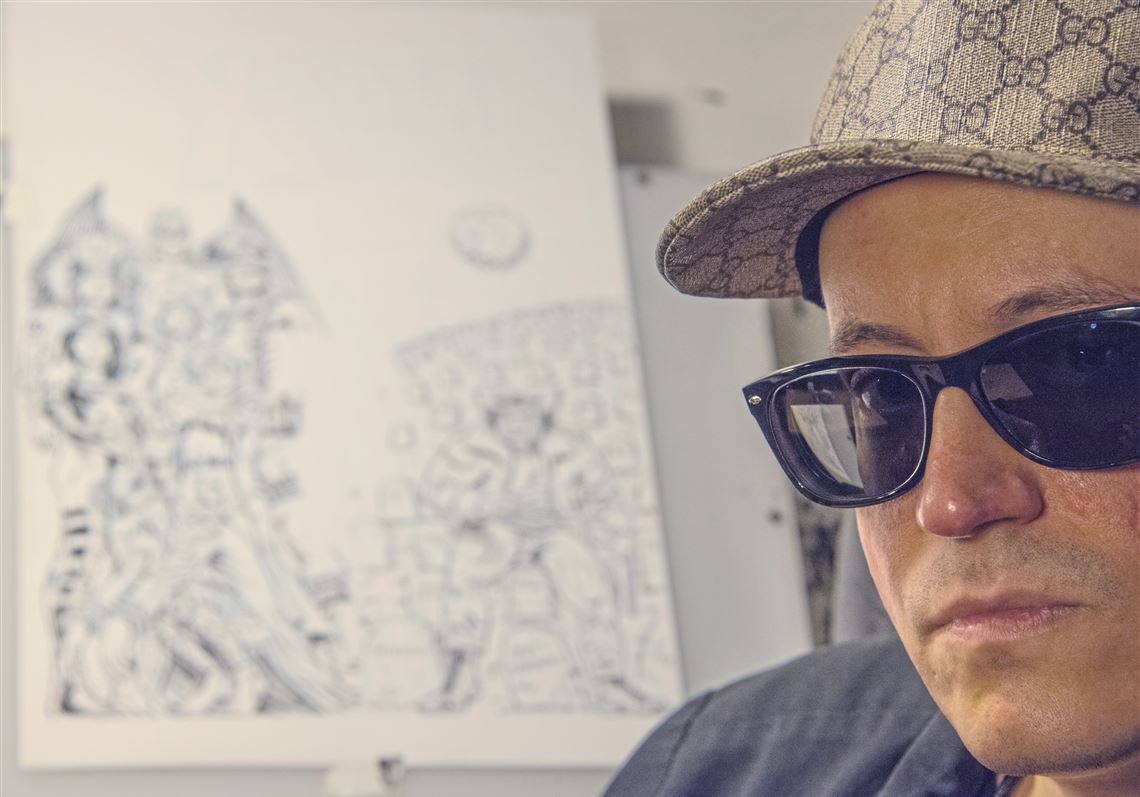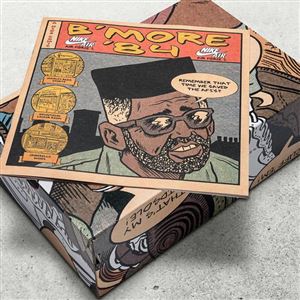When cartoonist Ed Piskor was in the sixth grade, he was obsessed with comics in general and Marvel’s “X-Men” titles in particular.
Nothing unusual about that. In the early 1990s, every fanboy with a pimple fixated on the adventures of the spandex-clad mutants. No one embodied the emo sensibility popular at the time better than they did. Still, the 34-year-old Munhall native wasn’t content to simply geek out like most comic book fans.
Mr. Piskor’s love for the characters and their labyrinthine storylines resulted in an urge to do his own version of their adventures. His parents saved his earliest drawings of Cyclops, Wolverine, Storm, Phoenix, Professor X and the whole mutant crew.
And his fanatical devotion to his craft has worked out well for him. Marvel Entertainment just announced that it will be debuting an X-Men limited series at the end of the year like none other in its history. “X-Men: Grand Design” will be written, drawn, inked, colored, lettered and designed by Mr. Piskor. Even the aged newsprint look of the books reflect Mr. Piskor’s nostalgia for the visual ambiance of Marvel’s treasury-sized comics from the 1970s. The only thing missing in his new project will be the distinct, pulpy smell of comics of that era.
“This has been a project 25 years in the making,” Mr. Piskor said as he flipped through plastic covered pages of X-Men comics he wrote, drew and lettered in the early ’90s. As he called up recently finished pages of “X-Men: Grand Design” on his iPad, the interview suddenly felt like a validation of Malcolm Gladwell’s famous 10,000 hours rule but with hundreds of hours to spare. “I grew up with the X-Men,” he said. “I know [its mythology] like the back of my hand.” For once that doesn’t sound like an exaggeration. Ed Piskor has been grinding toward this moment of artistic vindication for decades.
Since he was a boy hunched over drawing tables either in the garage or in the family’s very cold basement, Mr. Piskor has rarely missed a day drawing, whether comics or something else.
The New York Times best-selling author of “Wizzywig” and the multivolume “Hip Hop Family Tree” still lives in Munhall but has traded his parents’ unheated basement for his own house across town.
In the living room he has converted into an art studio, Mr. Piskor is surrounded by hundreds of pages of his own drawings and thousands of comic books and original art by other creators he admires.
His newest endeavor is a most singular achievement. Search the Marvel archives for the last time a lone creator has taken on so many duties in so many areas and you’ll come up empty. No other mainstream cartoonist — not Jack Kirby, Steve Ditko, Jim Steranko, John Byrne or Frank Miller — has done anything like it, at least in recent decades.
It is possible that some artist working in the obscurity of comic book sweat shops in the 1940s came close to matching Mr. Piskor’s creative output at one of the smaller publishers, but that effort was neither recorded or celebrated.
With the exception of Chris Robinson, his supervising editor at Marvel, Mr. Piskor has no collaborators. Besides providing a valuable sounding board, Mr. Robinson makes sure the cartoonist doesn’t violate the integrity of the characters or the Marvel brand.
“Working with Ed is an incredible honor! As a big fan of ‘Wizzywig’ and of course ‘Hip Hop Family Tree,’ seeing his process from the ground up is amazing,” Mr. Robinson said. “Ed might be the biggest ‘X-Men’ fan I know, so his recounting of the biggest moments in ‘X-Men’ history is being handled with loving care, naturally.”
Mr. Piskor enjoys the creative autonomy he has on the project.
“Marvel is making every effort to allow me to make the best books that I can make,” Mr. Piskor said. “They’re not hassling me. I give them two pages a week. They make no demands or put up deadlines.”
Mr. Robinson also praised Mr. Piskor’s artistry.
“Marvel has always celebrated unique, singular talents in the comics community and Ed is no different,” Mr. Robinson said. “He brings both voice and vision to the table, which is what separates great artists from the icons.”
Mr. Piskor made his reputation working for independent publishers such as Seattle-based Fantagraphics, a publishing house that nurtures the auteurist sensibilities of its cartoonists. Before that, he collaborated with the late Harvey Pekar on “American Splendor” and underground comics great Jay Lynch. He also has worked on graphic novels and even a series on early internet and phone-phreaking culture — “Wizzywig.”
What Mr. Piskor is doing for Marvel, the world’s biggest comic book publisher, is business as usual for a much smaller company like Fantagraphics, which immediately got behind the project he pitched to them more than half a decade ago.
“Hip Hop Family Tree,” Mr. Piskor’s multivolume history of the birth of rap and hip-hop culture in New York in the mid-’70s, is one of Fantagraphics’ best-selling titles ever. Like “X-Men: Grand Design,” Mr. Piskor wrote, drew, inked, colored, lettered and designed every inch of those award-winning books that can be found in every major book store in the country.
“This is the value of being a one-man shop,” Mr. Piskor said.
Mr. Piskor’s X-Men dream project pitch to Marvel started publicly on Twitter in 2015 when he tweeted something to the effect of: “Marvel should just let me do whatever Marvel book I want to do.”
It was an audacious maneuver, even for a commercially successful indie cartoonist like Ed Piskor. Within an hour, an obviously intrigued Axel Alonso, Marvel’s editor-in-chief, responded to the cartoonist by inviting him to pitch a specific project.
Mr. Piskor’s pitch was simple: “I have a way to make the first 280 issues of ‘X-Men’ look like they were planned that way,” he said of one of the most confounding and twisty narrative arcs in all of comics. “Good cartooning is the process of stripping things away. You can achieve good images without fussy lines. Clean up the verbiage and tell a story everyone can understand. I want to make a cogent, lean story that explains the X-Men saga to someone coming to it for the first time,” he said. “This may be the first X-Men comic people will ever read.”
The promise of a grand unifying theory of years of X-Men stories wasn’t something Mr. Alonso could take lightly, especially from someone with Mr. Piskor’s proven track record. After putting together an outline for a limited series, Mr. Piskor received the greenlight to proceed.
“If I didn’t have a New York Times best-selling, Eisner Award-winning series where I was able to prove I could sell a lot of books, Marvel wouldn’t have given me a shot,” he said.
For all of his dedication to his craft, Mr. Piskor acknowledges that his drawing style diverges dramatically from Marvel’s house style. His figures are far boxier and more cartoony than even the increasingly Manga-flavored style of many of Marvel’s current titles.
But that’s why Mr. Piskor believes his “X-Men” series will appeal to regular readers of the book — it is a departure from the usual into something intriguing, well-structured but different.
“I don’t read a lot of assembly line comics anymore,” he said. “I’m interested in a singular vision. I’m interested in the work of those who can create worlds. That’s why I want to see more comics by auteurs.”
Because Mr. Piskor’s previous projects will continue to generate royalties long into the future, he has more financial independence than most comic book creators and freelancers to only do those projects for Marvel and other big publishers that excite him.
“I’m not paying New York rent,” he said gesturing around his spacious art studio in Munhall. “The beauty of having a comic book that is selling regularly is that it gives me the opportunity to plan my career and not take assignments just to make rent.
“This [Marvel] thing is work-for-hire,” he said, “but it doesn’t feel like it. They’re not badgering me with dumb [stuff]. This is the first time someone who has gotten well beyond their 10,000 hours is making a comic book solo. That’s the gimmick,” he said before adding, “I like sitting down and coming up with my own ideas.”
Ed Piskor and fellow cartoonist Jim Rugg will co-headline the Carnegie Library’s “Meet the Author” summer reading author series at the Oakland branch, 4400 Forbes Ave., on Thursday from 6:30 to 7:30 p.m. Admission is free. For more information: 412-622-3151.
Tony Norman: tnorman@post-gazette.com or 412-263-1631.
First Published: July 21, 2017, 7:32 p.m.

















